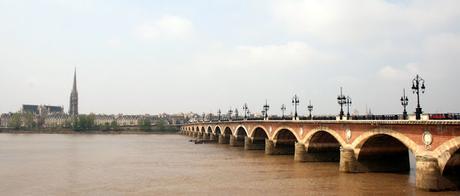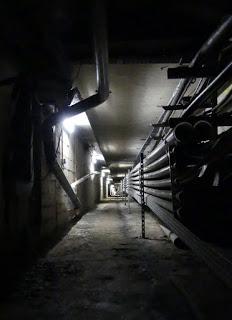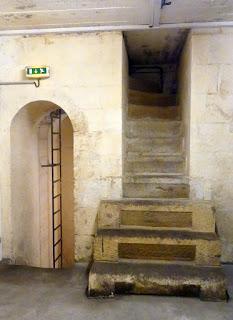 A few weeks ago, Invisible Bordeaux teamed up with la Mémoire de Bordeaux Métropole to head inside one of the city’s most famous landmarks, the Pont de Pierre, and met Laurent Rascouailles, the person who is in charge of visits to civil engineering works for Bordeaux Métropole.
A few weeks ago, Invisible Bordeaux teamed up with la Mémoire de Bordeaux Métropole to head inside one of the city’s most famous landmarks, the Pont de Pierre, and met Laurent Rascouailles, the person who is in charge of visits to civil engineering works for Bordeaux Métropole.The resulting video interview was subsequently published by Mémoire de Bordeaux Métropole on social media, and here is what Laurent taught us about the inner secrets of the emblematic bridge.
1. The Pont de Pierre is hollow!

Inside view of the Pont de Pierre!
Laurent Rascouailles: "Two tunnels run from one bank to the other inside the bridge, carrying water lines through the first, and telecommunications and electrical cables through the other. The tunnels are low-ceilinged, 1.10 meter high on average, and the only people who use the tunnels these days are the technicians who monitor the bridge. Generally they cross the bridge once a year, to check the inside of the structure. They go inside each pillar, and it takes them half a day to make it all the way across the bridge."In August 1944, the Spanish guerilla Pablo Sanchez saved the bridge simply by walking through these tunnels. The Germans had positioned explosives inside each pillar in order to blow up the bridge. Pablo Sanchez defused all the explosives; sadly he was shot when exiting the bridge on the left bank. There is a plaque in his honor on the waterfront and his name was recently given to a road in the new dockside developments."
2. Instruments permanently monitor the bridge
Laurent Rascouailles: "There are instruments inside each pillar and in its abutments, to monitor all the bridge's movements. There is a displacement sensor in each abutment and each pillar, to keep track of how much the pillars are sinking into the ground. Then there is an inclinometer to know which way the pillars are leaning in relation to the river, whether it's upstream or downstream. And a mechanical level enables us to monitor the transversal and longitudinal rotations of its supports."
3. Steps that now lead nowhere... used to provide underground access to toll collection offices!

Stairway to nowhere.
Laurent Rascouailles: "When construction work began, the State funded the project. But work came to a halt when Napoleon abdicated in 1814 and it was the shipowner Pierre Balguerie-Stuttenberg who enabled work to start again, by seeking donations. He founded the Compagnie du Pont de Bordeaux, made up of Bordeaux traders and other shipowners. Thanks to the company, building work began again but, in return, they demanded a toll be implemented for a 99-year period. Therefore, when the bridge opened on May 1st 1822, everyone had to pay in order to cross."The toll system stopped in August 1861 when the State acquired the bridge with the support of the city of Bordeaux and the département. One of the conditions was to make the bridge free to cross, so that Bordeaux could expand on the right bank, towards La Bastide. The toll booths were then used to collect octroi duty tax from 1861 until its abolition in 1927, and the buildings were finally demolished in 1954 when the bridge was widened, from a width of around 15 metres to 19 metres. At ground level, the pavements you walk on these days were added when that extension took place. The duty collection buildings had become a hindrance for movement and, therefore, hindered access to the bridge."
And here is the video interview featuring some incredible archive footage (and English subtitles):
Click here if video does not display properly on your device.
> Video produced by Sandie Fabre for la Mémoire de Bordeaux Métropole in conjunction with Invisible Bordeaux, Bernard Avril and IJBA, originally published on Vimeo: https://vimeo.com/228215463> Ce dossier est également disponible en français !
